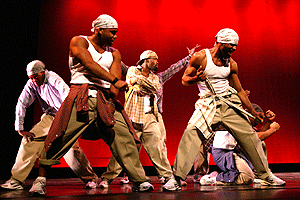3.) Making a Lexicon – Observation of Intrinsic Elements
 Introduction:
Introduction:
Last session the class examined data collected from interviews about dance and movement preferences and thought about that data from a variety of socio-cultural perspectives. The class also made collages to further explore their personal preferences. Today, the class explores intrinsic (observable) elements in dance and movement observation and extrinsic elements (interpretations and evaluations).
Classroom activities:
Show two video clips, Madonna’s Vogue and Rennie Harris’ Students of the Asphalt Jungle. As they observe, studentsmake note of the features that stand out for them. These should be specific movements, spatial arrangements, costume elements, aspects of the music, and the like. Ask: What did you see? What stood out for you? Encourage students to be basic and detailed in their responses, with answers like, "little circular hand gestures," "jumping," "all men," "unison rhythm," "strong beat," "wearing corsets," etc.
-
Create a lexicon featuring student observations of each video clip. Post student observations (one list per video observed). Facilitate a discussion that encourages students to compare the two clips.
-
Sort learner responses into dance elements: space, time, shape, focus of attention, quality of energy, clothing, paraphernalia, setting, "story"/narrative. If students have overlooked obvious features, e.g., rhythm or music, then lead them towards an appropriate response by asking questions about that element. Explain these features as “intrinsic” elements of the dances viewed and that the list of features developed constitutes the dance's “lexicon.”
Discuss the difference (and the relation between) observation of intrinsic elements and interpretation or evaluation based on extrinsic, contextual elements.
- Intrinsic elements: include everything you can discern from observing the dance.
- Extrinsic elements: include any contextual information, interpretation, or evaluation the observer brings to viewing such as "They are wearing clothes from the 1980s" (depends on observer's previous knowledge); "They are happy" (interpretation); or "They are terrific dancers" (evaluation). Extrinsic factors enable us to make connections, put information in context, and make judgments. If students give evaluations or interpretations rather than observations, they can be encouraged with, "What did you see or hear that gave you that impression?" Note that observation always underlies interpretation and evaluation. For example, "They are terrific dancers" might be based on the observation, "Their toes are pointed and they kick to the same height."
- Explain that the best descriptive writing relies on action verbs, and secondarily on metaphors and adjectives. Refer to the lexicon developed in class as containing action verbs, metaphors, and adjectives and to students' essays on their movement memories as they relate to good descriptive writing.
Gather ideas about the extrinsic factors of the Madonna and Rennie Harris videos. Questions to ask include:
- What were your personal responses to the Madonna and Rennie Harris videos (versus the intrinsic features you observed)? What influenced your responses? For example, is your understanding of current pop culture an influence? Do you know how to do the dance in the video? Have you seen similar videos?
- Did either movement style conform to your own ideas of beauty? In what specific ways?
- What is your own current model to emulate?
- Consider gender. Do you associate "beauty" with either male or female gender? What might it mean to say we perform gender?
- Note: If there is time, show excerpts of "Paris is Burning" with historical background.
Closing:
To close class, review that in this session, the class differentiated between intrinsic and extrinsic elements in viewing dance and movement and began to discover the contextual knowledge (and values) one brings to viewing dance and movement.
Homework:
- With a partner, makea one-minute dance or movement study in which you create an idealized persona using movement, gesture, clothing, and/or props. Students can both depict the same ideal or choose different ideals, but in either case, they must interact with each other in a mock competition. [Hints: Feel free to "borrow" from the videos, collages, movies, TV, gender and ethnic stereotypical ideals, and professional ideals.]
- Read Sklar, D. (1991) “Five Premises for a Culturally Sensitive Approach to Dance.” Review Siegel, Marcia. "Rethinking Movement Analysis" and Sklar, Deidre. “Movement Observation Checklist.”

